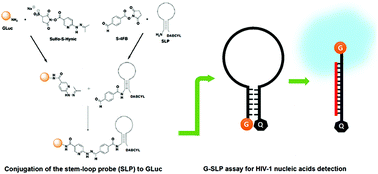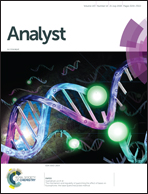Design of Gaussia luciferase-based bioluminescent stem-loop probe for sensitive detection of HIV-1 nucleic acids†
Abstract
Here we describe the design of a bioluminescent stem-loop probe for the sensitive detection of HIV-1 spliced RNA. In this study, we employed Gaussia luciferase (GLuc), a bioluminescent protein that has several advantages over other bioluminescent proteins, including smaller size, higher bioluminescent intensity, and chemical and thermal stability. GLuc was chemically conjugated to the DABCYL-modified stem-loop probe (SLP) and was purified with a 2-step process to remove unconjugated GLuc and SLP. The binding of the target RNA to the loop region of the SLP results in the open conformation separating the stem part of SLP. GLuc conjugated to the stem acts as a reporter that produces light by a chemical reaction upon adding its substrate, coelenterazine in the presence of the target, while DABCYL serves as a quencher of bioluminescence in the closed conformation of SLP in the absence of the target. The optimized GLuc based-SLP assay resulted in a signal-to-background ratio of 47, which is the highest reported with bioluminescent SLPs and is significantly higher compared to traditional fluorescence-based SLPs that yield low signal to background ratio. Moreover, the assay showed an excellent selectivity against a single and double mismatched nucleic acid target, low detection limit, and ability to detect spiked HIV-1 RNA in human serum matrix.



 Please wait while we load your content...
Please wait while we load your content...